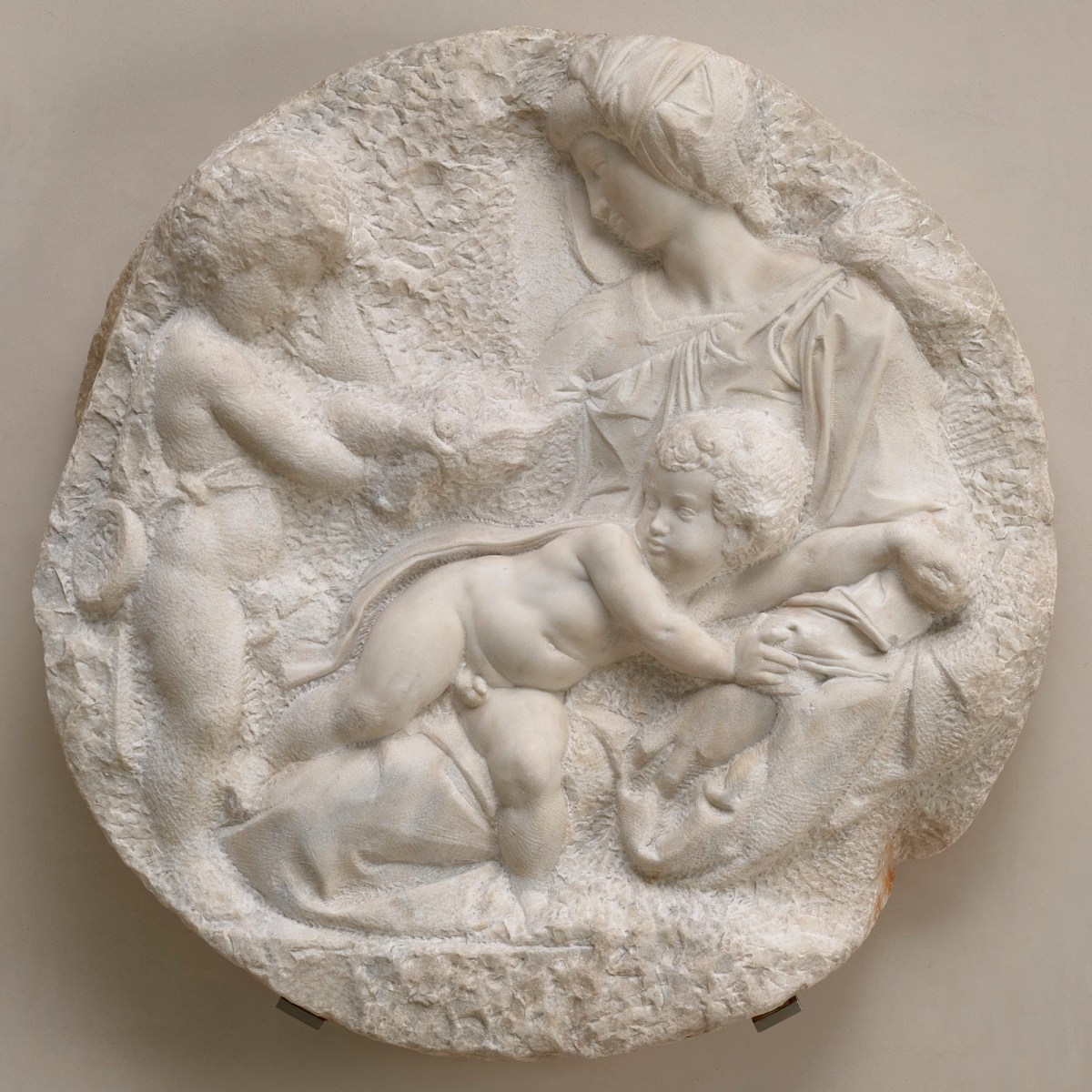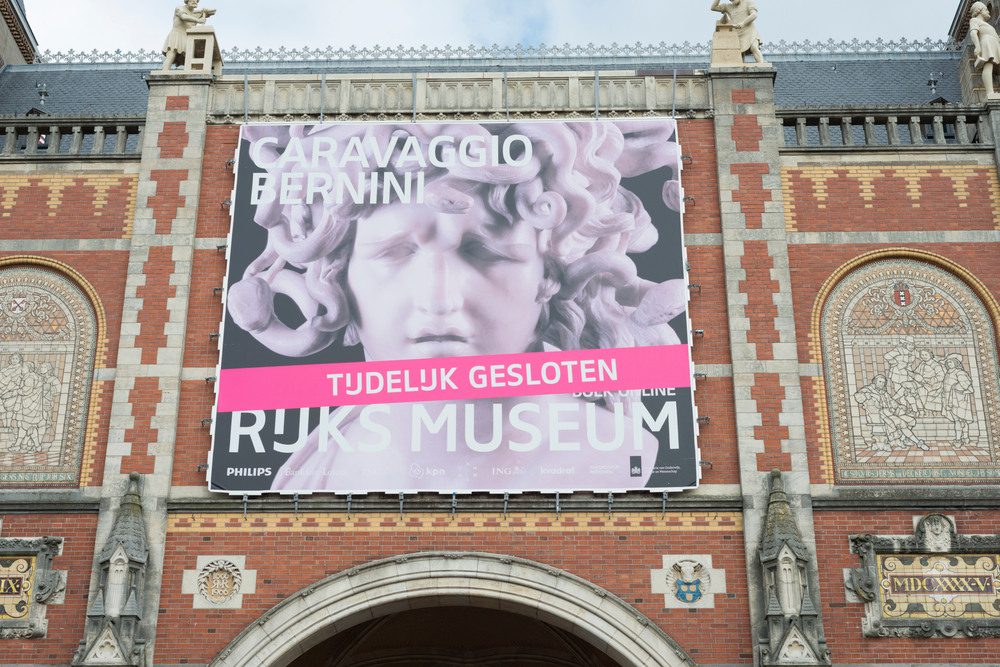Deaccessioning vs. Inalienability: how museums are coping around the world…
[09.02.2021]
Michelangelo Buonarroti, Taddei Tondo : The Virgin and Child with the Infant St John, Royal Academy of Arts
Usually when a museum is mentioned in the context of an auction sale, it is in relation to the preemption of a work and not its sale… However, with the pandemic hitting the arts sector so hard, a number of institutions have either sold or are considering selling valuable works to keep themselves afloat. London’s Royal Opera House recently sold the Portrait of Sir David Webster by David Hockney and New York’s Brooklyn Museum has had to part with a MONET, a MIRO and a DEGAS… The recent success of Botticelli’s Portrait of a young man holding a roundel at auction could well encourage the London’s Royal Academy of Arts which wants to raise cash by selling Michelangelo’s Tondo Taddei, the only sculpture by the great master kept in Great Britain. Unthinkable? Unfortunately not. Sales catalogues seem to be filling up with museum pieces from institutions seeking to avoid complete closure. However, some are prevented by law from deaccessioning their most precious treasures…
Two cultural models at loggerheads
The United States, being a federation of states, the Federal government intervenes very little in the nation’s cultural affairs. There is no equivalent of France’s Ministry of Culture, but rather a multitude of transversal governmental entities which are responsible at the Federal level for what Americans call “The Arts”. The National Endowment for the Arts, the National Endowment for the Humanities, and the Institute for Museum and Library Services are funded by Congress, and their chairpersons are appointed by the White House.
The Association of Art Museum Directors (AAMD) is an alliance of museum directors from across North America, Canada, Mexico and the United States. State and Education departments have their own arts programs at the local state level. The only two national art museums – the National Gallery of Art and the Smithsonian Institution – are in Washington. The other museums are therefore mostly private, even if they receive subsidies from their city or state.
Private sponsorship, space rental and ticket sales are just some of the sources of funding that these institutions rely on. Like most American cultural institutions (philharmonic orchestras, theatre troupes, ballets, etc.) they are non-profit organizations and therefore benefit from substantial tax relief. However, apart from this NPO status, American museums face much the same problems as private companies in times of crisis and are forced to either lay off staff (the MoMA laid off 17% of its employees in 2020 with revenue down 80% vs. 2019.) or cancel projects or not renew contracts… After several months of total closure followed by a partial reopening, the return of visitors has been far too meager to cover the revenue shortfalls, especially as there are hardly any tourists among the visitors. Some major institutions are on the verge of bankruptcy and risk closing. Others no longer have enough cash to cover their operating costs. The Brooklyn Museum needs $40 million just to maintain its existing collections and pay employees’ salaries. Last October, the museum parted with 12 of its treasures during several sales at Christie’s NY, including a masterful Lucretia by Lucas I CRANACH and Italienne debout tenant une cruche by Camille Corot.

Lucas Cranach I, Lucretia
In the United States, deaccessioning is therefore considered a business practice like any other to “get out of a rut”, although it is in reality scrupulously framed by codes of ethics issued by each museum on the advice of the AAMD. In normal times, “the alienation of works is a legitimate part of building and maintaining collections. The funds from the sale of a work can only be used for the acquisition of other works”. In other words, deaccessioning a work must serve only one purpose: to finance future acquisitions deemed more relevant for the museum. However, in view of the impact of the global pandemic, the AAMD has relaxed its rules for two years, announcing that it would not penalize museums which resell part of their collection “to pay expenses linked to the maintenance of collections” (a relaxation due to expire on 10 April 2022). This shows the seriousness of this unprecedented crisis: the AAMD had strongly condemned the Detroit’s emergency manager in 2008 for considering selling off the works of the Institute of Art or, more recently, in 2018, the Berkshire Museum in Pittsfield when it sold _ after a court battle _ more than 25 works in order to get back on its feet. In short, it seems we are likely to see lots of museum artworks on the market over the next two years. A question mark nevertheless remains over whether this influx of works will benefit both sellers and buyers.
And in Europe?
European museums are subject to the same covid-related constraints as their counterparts across the Atlantic. All cultural institutions have been closed down repeatedly with their staff working from home and the public barred from visiting permanent collections or exhibitions which, for the most part, have been either postponed or cancelled. Since the start of the crisis, the Louvre has a revenue shortfall of around $70 million. Attendance at the famous museum plummeted last summer, particularly as foreign tourists usually account for 75% of its visitor base. Indeed, all the major museums in the French capital have suffered more or less the same impact for the same reason. Regional museums (outside Paris) have fared better because they are generally less reliant on international tourism.

Closed Rijksmuseum in Amsterdam, NL
There are clearly two models in Europe: British, Scandinavian and German museums generally follow the American model to varying degrees. Museums, even public institutions, must generate their own funds by relying on ticketing, events and patronage to function. But France, Italy and Spain (among others) have converted the collections of their kings and princes into public collections. According to France’s Heritage Law (Article 451-5), “the artefacts in the collections of France’s publicly-owned museums are public property and are, as such, inalienable”. In other words: the law prohibits the sale of artworks from the collections of public museums, which, compared to private museums, represent the vast majority in France. The notion of inalienability, which guarantees the transmission of artistic heritage and protects it from the vagaries of the art market, has been anchored in French law since the Ancien Régime. When Louis XIV was submerged by debts generated by decades of war, he preferred to melt all his silver furniture than to sell a single painting from the royal galleries. Until 2002, it was quite simply forbidden to remove an object from a French cultural institution, except in the context of an exhibition loan. The rules were clarified with the Museums Law (2002) which authorizes the decommissioning of works in very rare cases, subject to approval by a commission which may examine the possibility of ‘returning’ certain objects. In the coming months 26 works from the Trésor du Béhanzin conserved at the Quai Branly-Jacques Chirac Museum will be returned to Benin (after a formal request launched in 2016).
Although works can now be ‘returned’, their sale is still prohibited! This situation has generated a lot of debate about the logic of such a law in times of crisis. A lot of people seem to believe museums possess massive reserves of works and/or duplicates that they can sell in hard times. Initiatives to relax French law (i.e. closer to the Anglo-Saxon model) surface every time a new government comes into power. In 2008, the Scientific Commission of French Museums, the sole decision-maker regarding decommissioning, was almost dissolved. But movements in this direction have been frustrated by fears of the potentially damaging consequences; while it is clear no-one would suggest selling the Mona Lisa, the question of which works should leave the picture rails or the reserves of a museum to end up on the walls of a private home remains as thorny and as complicated as ever.
Among the numerous considerations that fuel the debate there is the progress of scientific and historical research whereby certain artworks are restored or re-attributed and others are identified. Then there is the old chestnut of outmoded style: the Musée d’Orsay is certainly glad to have scrupulously preserved the large-format history paintings by the likes of Alexandre CABANEL, Dominique Louis PAPETY and William Adolphe BOUGUEREAU. These so-called academic artists, long considered kitsch and out of fashion, form the main body of the museum’s collections today. A third consideration relates to works that are donated as a whole and are therefore, a priori, not supposed to be separated. An artist or a collector wishing to give or bequeath all or part of his work or collection to a museum may think twice if museum sales are authorized.
Bernard de Montferrand, Director of Frac Aquitaine in 2013, reminds us of a somewhat chilling observation made decades ago by André Malraux: “without donations and the support of private collectors, the great French museums would have neither Impressionist nor Cubist and hardly any Surrealist works. Nowadays, our museums rely heavily on these Modern masters to attract the crowds”.
So how are French museums (and those in Europe which follow the inalienability model) actually surviving the pandemic? The majority are receiving some form of state aid. The people who run these museums are mainly civil servants paid by the state which allocates an annual budget for operating costs in addition to the revenues generated by the museums’ activities. When the crisis is over, the economic consequences of the pandemic will therefore be clearly visible in the general mass of public debt. For the time being, no french public museum has had to lay off workers, and the artistic heritage remains intact for future generations.




 0
0
